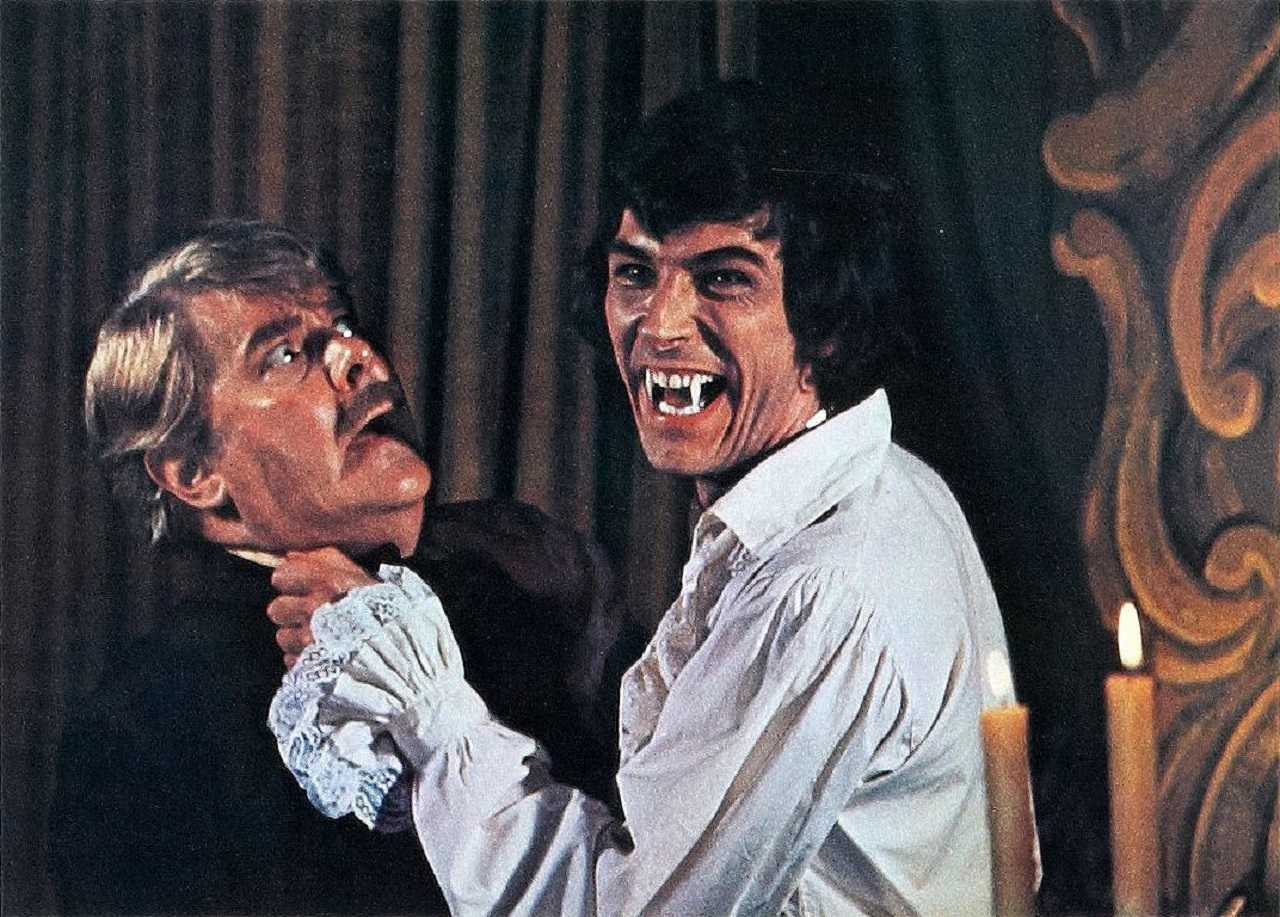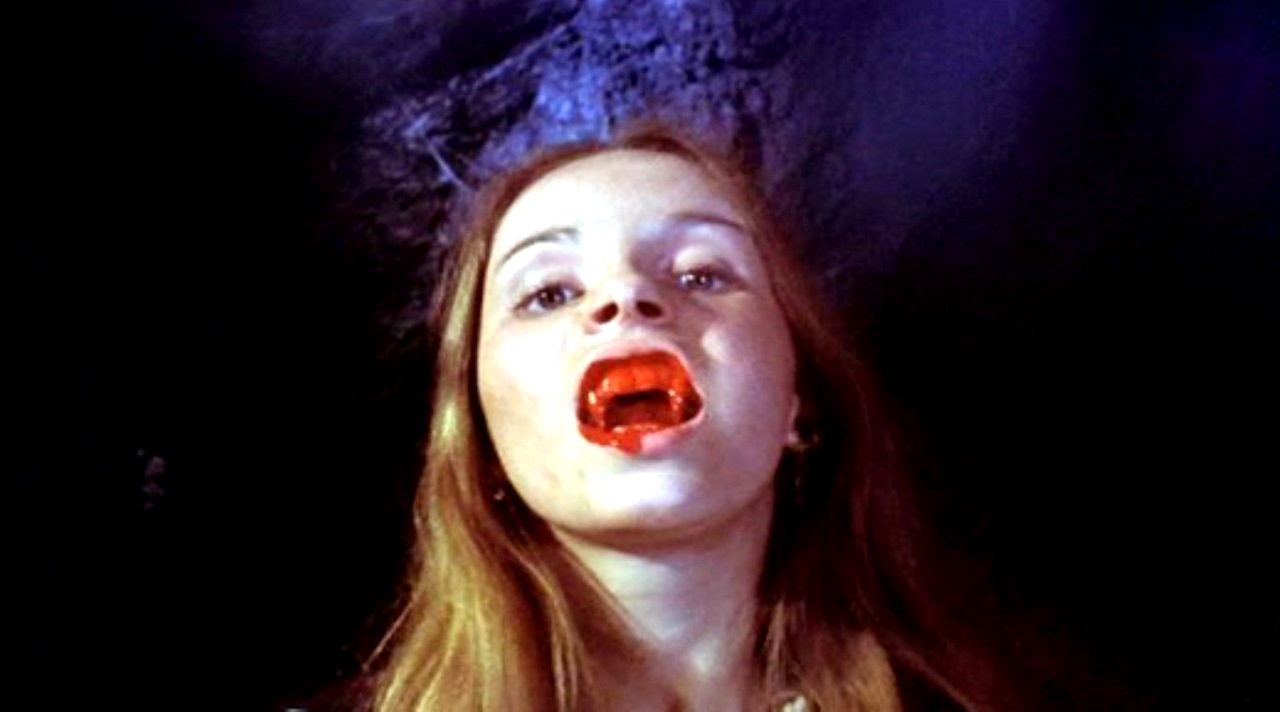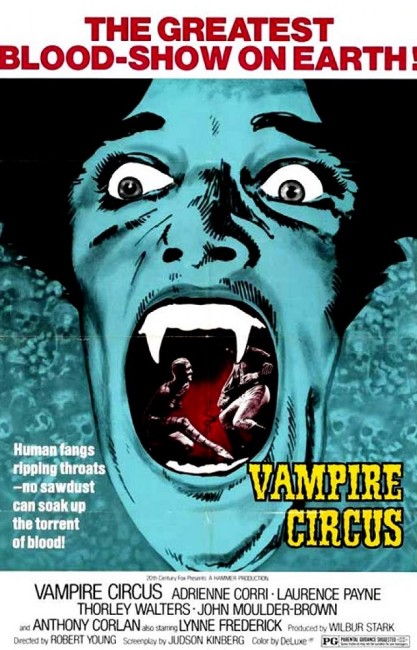Crew
Director – Robert Young, Screenplay – Judson Kinberg, Producer – Wilbur Stark, Photography – Moray Grant, Music – David Whitaker, Music Supervisor – Philip Martell, Special Effects – Les Bowie, Makeup – Jill Carpenter, Art Direction – Scott MacGregor. Production Company – Hammer.
Cast
Adrienne Corri (Gypsy Woman), John Moulder-Brown (Anton Kersh), Anthony Corlan (Emil), Thorley Walters (Burgomaster), Lynne Frederick (Dora Mueller), Laurence Payne (Professor Mueller), Elizabeth Seal (Gerta Hauser), Robert Tayman (Count Mitterhouse), Skip Martin (Michael), Richard Owens (Dr Kersh), Robin Hunter (Hauser), Robin Sachs (Heinrich), Lalla Ward (Helga), Domini Blythe (Anna), Dave Prowse (Strongman), John Bown (Schlit), Roderick Shaw (Jon Hauser), Barnaby Shaw (Gustav Hauser), Mary Wimbush (Sylvia), Christina Paul (Rosa)
Plot
The villagers of Schtetel find that the vampire Count Mitterhouse has abducted a young girl and drunken her blood, as well as seduced the wife of one of the villagers. In anger, they stake the Count and burn his castle to the ground. Count Mitterhouse dies promising that he will drink the blood of their children to return to life. Fifteen years later and Schtetel is suffering from a plague. All the surrounding villages have quarantined Schtetel, shooting anybody who tries to get in or out. The village is visited by the Circus of Nights. The circus’s performers enchant the villagers with their seemingly magical abilities. However, they are in reality the vampire brood of Count Mitterhouse and have come to seduce the children of the village and devour their blood in order to resurrect the count from his coffin.
Vampire Circus is a Hammer horror film. It comes from the latter days of the studio in the 1970s, the period when the old Hammer guard was retiring in favour of new producers who were more commercially minded. The new Hammer team made a concerted effort to appeal to the youth market, as well as add a much more openly sexual element to the films. The new Hammer guard began milking the company’s Dracula and Frankenstein films for all they could, as well as rearranging the old favourites in a variety of combinations.
During this time we saw a host of vampire films that tried to do something new – the lesbian sex vampire in the Karnstein series begun with The Vampire Lovers (1970); a modernised Dracula in Dracula A.D. 1972 (1972) and The Satanic Rites of Dracula (1973); the vampire swashbuckler in Captain Kronos – Vampire Hunter (1974); and the vampire/kung fu film in The Legend of the 7 Golden Vampires (1974). Among these, Vampire Circus was one of the more creative efforts.
Part of the reason for Vampire Circus‘s effectiveness may simply be that it had none of the regular personnel involved – it was made almost entirely by new faces. There’s no Terence Fisher’s, Roy Ward Baker’s, Anthony Nelson Keys’ or Michael Carreras’s present behind the scenes; no Christopher Lee’s, Peter Cushing’s, Michael Gough’s, Michael Ripper’s, Ralph Bates’s, Ingrid Pitt’s, Veronica Carlson’s present in the cast – the only cast members who even appeared in another Hammer film before were Thorley Walters who had a supporting part as the Renfield equivalent in Dracula – Prince of Darkness (1966) and had been in two Hammer Frankenstein films, Dave Prowse who had previously been the monster in The Horror of Frankenstein (1970) and Adrienne Corri who played a small part as a Lunar cop in Moon Zero Two (1969).

Indeed, none of the directing, writing and producing crew ever worked for Hammer again following Vampire Circus – Robert Young did direct an episode of the Hammer’s House of Horrors (1980) tv series but that is it. Certainly, there are some interesting names on the credits that did go on to play roles in other things – the mute strongman is played by Dave Prowse who a few years later became the body of Darth Vader in Star Wars (1977) and the first two sequels; while one of the vampire twins is played by Lalla Ward who went onto play the second incarnation of Romana in tv’s Doctor Who (1963-89) and to marry the fourth Doctor, Tom Baker.
Vampire Circus has a fine opening that was all about what Hammer was trying to market itself as at the time – a young, handsome sexy vampire count; naked women; a dash of sadism (a woman flogged by the villagers); a dash of gore (throats slit, the vampire staked); and of course conservative tradition symbolically asserted at the end, along with the promise of the vampire’s resurrection and revenge. It is a very lively opening that bodes well for the rest of the film.
What follows at times resembles Ray Bradbury’s Something Wicked This Way Comes (1963). (See the film version Something Wicked This Way Comes (1983) for details). Both Vampire Circus and Something Wicked This Way Comes feature a sinister circus come to town to prey upon the innocent villagers where the performers are supernatural in origin. Both also feature halls of distorting mirrors that are more than they seem, as well as the characters of two boys who sneak away to the circus and get in trouble. Where Bradbury gets sentimental about some kind of lost smalltown America and his vision of evil is traditional, Vampire Circus presents a much more sensual and lasciviously threatening vision of evil – indeed, what Vampire Circus draws upon is the image from the original Dracula/The Horror of Dracula (1958) of the vampire as a primal, sexual threat who sways with a charismatic magnetism.

The circus performances are imbued with a fantastique magic and lush eroticism – the tamer and his dancer, a nude woman who is body-painted as a tiger and lithely prowls around him in a strikingly erotic dance; a black panther leaping through the air and in an effective stop-action cut transforming into the swarthily handsome Anthony Corlan who approaches a girl with piercing intent; bats fluttering through the air and gracefully transforming into twin brother-sister tumblers; spooky scenes with the twins appearing both in and out of a mirror, before the reflections drag the victims inside the mirror with them. The effects are all conducted through the use of simple stop-action effects. Certainly, compared to today’s CGI transformations, some of the stop-action transformations and particularly the bat effects look shoddy, but held a genuine sense of evocative fantastique at the time the film was made.
The latter third or so of Vampire Circus travels in traditional Hammer directions with the villagers combatting the circus people, staking the vampire menace, restoring the status quo and so on but for a time Vampire Circus does craft something imaginative out of the staple Hammer elements.
Robert Young went on to become a regular director on British tv and various films. His only other genre work was the tv mini-series The Infinite Worlds of H.G. Wells (2001) and the horror film Curse of the Phoenix (2014).
(Review copy provided by Kathy Tipping)


